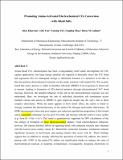Governing Role of Solvent on Discharge Activity in Lithium–CO₂ Batteries
Author(s)
Khurram, Aliza; Gallant, Betar M. (Betar Maurkah)
DownloadAccepted version (2.398Mb)
Publisher Policy
Publisher Policy
Article is made available in accordance with the publisher's policy and may be subject to US copyright law. Please refer to the publisher's site for terms of use.
Terms of use
Metadata
Show full item recordAbstract
Non-aqueous Li-CO2 batteries reported in literature have almost exclusively relied upon glyme-based electrolytes, leading to a hypothesis that they are uniquely active for CO2 discharge. Here, we study the effect of electrolyte composition on CO2 activity to examine whether this is the case. The results indicate that TEGDME-based electrolytes containing moderate concentrations of Li+ salts (roughly within the range of 0.7-2 M examined herein) are most conducive to CO2 activation, especially compared to dimethyl sulfoxide and propylene carbonate-based electrolytes. Through electrochemical, spectroscopic, and computational methods, we determine that glymes have lower desolvation energies for Li+ compared to other solvent candidates, whereas high salt concentrations increase the local density of Li+ surrounding CO2 and reduction intermediates. These attributes collectively increase the availability of Li+, crossing a threshold necessary to support CO2 activation. Discharge voltage and reaction rates are also sensitive to the alkali cation identity, further invoking its key role in enabling or suppressing reactivity.
Date issued
2019-11Department
Massachusetts Institute of Technology. Department of Mechanical Engineering; Massachusetts Institute of Technology. Institute for Data, Systems, and SocietyJournal
Journal of Physical Chemistry Letters
Publisher
American Chemical Society (ACS)
Citation
Khurram, Aliza et al. “Governing Role of Solvent on Discharge Activity in Lithium–CO₂ Batteries.” Journal of Physical Chemistry Letters, 10, 21 (November 2019): 6679-6687 © 2019 The Author(s)
Version: Author's final manuscript
ISSN
1948-7185